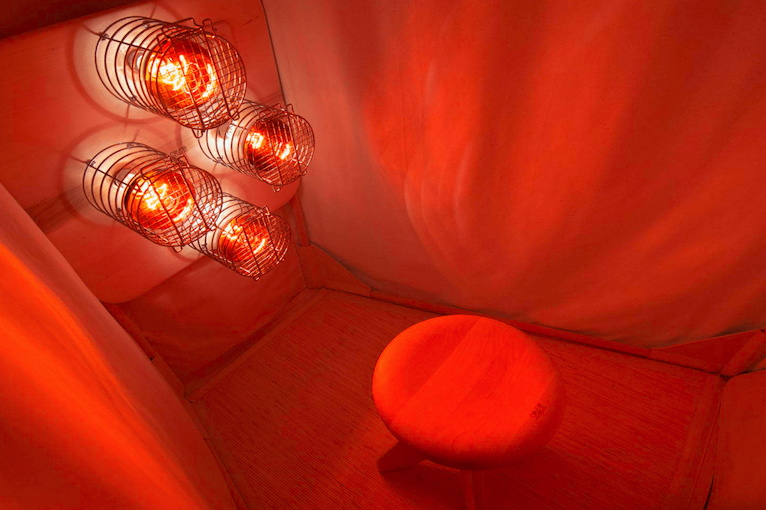- HOME
- Infrared Sauna Insights
- Steam Sauna vs Infrared
Steam vs Infrared Saunas: Heat Therapy Showdown 2025

Saunas are an increasingly popular choice for many people to relax, refresh, and rejuvenate.
With the rise of technology, there are now two main types of saunas available on the market: The infrared sauna and the more traditional steam sauna.
While both offer similar benefits, they differ in their heating methods, temperature, energy use, the benefits for health and wellbeing, installation process, and maintenance.
In this blogpost we are going to evaluate these 6 key differences. Perhaps we won’t be able to settle the heated “infrared sauna vs steam sauna” debate, but it will help you decide which one best fits for your quest for health and wellness.
1. Heating Mechanism
As far as saunas go, the heating mechanism is a key factor in the choice between an infrared sauna and a steam sauna.
In a steam sauna, the principle involves heating up rocks or elements that then heats water and creates steam. This vapor is what provides the heat and humidity in the sauna.
An infrared sauna uses infrared heaters to directly emit heat on and into the body. Heaters of the infrared sauna use electromagnetic radiation to heat the body, permeating it with a gentle and even warmth.
The different heating mechanisms means that the experience of each sauna is unique: Steam saunas generate a more intense and steamy environment, where infrared saunas produce a more gentle and dry heat. Ultimately, the choice is one of personal preference and the desired sauna ‘feel’ and effects.

2. Temperature Variations
When it comes to temperature variations, steam saunas and infrared saunas diverge as well.
The temperature in a steam sauna can reach higher levels due to the vapors made by heating water. This can result in an increasingly intense and sweaty sauna session, which is perfect if you enjoy a higher level of heat and humidity.
Infrared saunas, infrared blankets, and PEMF mats operate at lower temperatures but still provide a profound, penetrating heat. This makes them a great option for those who rather have a more gentle and dry heat experience.
Ultimately, in the infrared vs steam comparison, the temperature variations between the two sauna environments is a matter of comfort levels. What feels pleasant to you, I might find uncomfortable, and the other way around.

3. Energy Efficiency
Traditional steam saunas require a considerable amount of energy to heat the rocks or elements that generate steam, possibly resulting in higher energy consumption and higher utility bills.
Their cousins, infrared saunas, in the shape of cabins, tents, domes, mats or blankets, are known for energy efficiency. Infrared heaters emit heat directly on and even beyond the surface of the body, losing less energy on warming the surrounding space. This saves on energy costs and minimizes the environmental impact.
So, if you're looking for an option that is more energy-efficient, sustainable and eco-friendly, IR sauna may be the way to go.
4. Health Benefits
As a wellness enthusiast, you're probably interested in how saunas can improve healthiness and wellbeing. Both steam saunas and infrared saunas present unique advantages.
Known for their ability to create detox and weight loss effects through intense sweating, which helps to remove toxins from the body and burns fat, the steam sauna elevates relaxation, amps up circulation, and can soothe sore muscles.
You may expect your home infrared sauna to provide similar benefits, but with the added action of its rays penetrating deep into the body, targeting muscles and joints. This makes them ideal for decreasing pain and inflammation.
Whether you're looking to detoxify, alleviate pain, or other health perks, both saunas offer a range of health benefits to support your wellness intentions.

5. Installation and Space
These typically require more installation space due to necessary components such as a steam generator, adequate ventilation, and drainage systems. Additionally, plumbing is essential to provide water for the steam, which can complicate the setup process and often necessitates professional installation.
A space-saving alternative within this category is the shower-steam combination, which integrates the steam sauna function into a regular shower setup, thereby conserving space. For people seeking mobility, portable steam sauna tents are available, ranging from 1 to 4-person capacities, which can be set up and dismantled with relative ease.
Typically, infrared saunas cabins are simpler to install and require significantly less space, making them suitable for various environments, from small apartments to spare rooms. The portable options like sauna domes, personal tents, blankets, and PEMF mats are especially convenient for those with limited space or the need for mobility.
For permanent installations, cabin IR models eliminate the bulky steam generation equipment, offering a streamlined and space-efficient design. Both steam and infrared saunas feature portable versions, providing flexibility and practicality.

Sauna blanket: the most affordable and user friendly home infrared sauna
6. Maintenance and Longevity
Where maintenance and longevity are considered, both types of sauna have their own considerations. Steam saunas require regular maintenance to ensure that the steam generator and plumbing are functioning properly. It is important to clean and sanitize the sauna regularly to prevent the buildup of mold or bacteria.
Infrared saunas don’t demand intensive maintenance. The infrared heaters typically have a longer lifespan and do not require the same level of upkeep as steam saunas. Having said that, it is still important to clean the sauna regularly and check for any issues with the heating elements.
Overall, both types of saunas can provide years of relaxation and benefits, given the proper maintenance and care.
So, in either case, and regardless of which side of the fence you land in the ‘steam sauna vs infrared sauna debate’, it’s prudent to follow the manufacturer's guidelines for maintenance to ensure the longevity of your sauna experience.

Sam Everhart
Interested in learning more? Check out more insights or find additional resources below. Find more helpful tips, expert reviews, and in-depth guides on PEMF mats, sauna blankets, and wellness tech at saunace.com.

